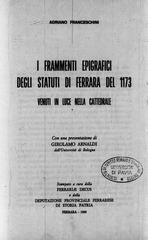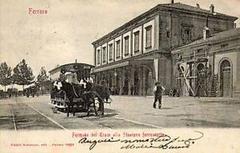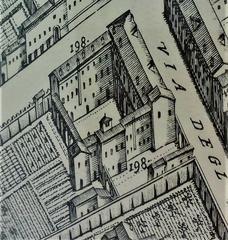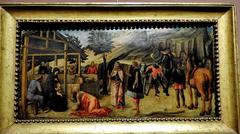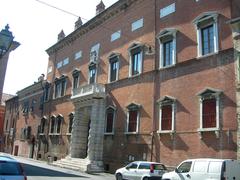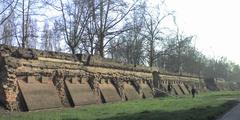Ex Convento di San Nicolò, Ferrara: Visiting Hours, Tickets, and Historical Guide
Date: 14/06/2025
Introduction
The Ex Convento di San Nicolò stands at the core of Ferrara, Italy, as a living testament to the city’s deep religious, architectural, and social heritage. Originating in the 12th century, this former convent encapsulates Ferrara’s transformation from its medieval beginnings through its Renaissance zenith, shaped by visionaries such as architect Biagio Rossetti. Dedicated to Saint Nicholas, the convent has historically been a center for charity, education, and community engagement. Today, its preserved cloisters, frescoes, and architectural forms continue to inspire visitors, while its role as a cultural venue anchors it within Ferrara’s vibrant urban fabric. This guide provides comprehensive, up-to-date information on the Ex Convento di San Nicolò’s history, visiting hours, ticketing, accessibility, and proximity to other essential Ferrara attractions, ensuring an enriching visit for every traveler (My Italian Diaries, Fondazione Estense, Tripsavvy).
Table of Contents
- Historical Overview
- Cultural and Religious Significance
- Notable Historical Events
- Visiting the Ex Convento di San Nicolò
- Frequently Asked Questions (FAQ)
- Conclusion
- References
Historical Overview
Origins and Foundation
The Ex Convento di San Nicolò traces its beginnings to the 12th century, during which Ferrara was blossoming as a significant urban center in Emilia-Romagna. Initially established outside the city’s medieval walls, in what was then called the “borgo,” the convent was dedicated to Saint Nicholas, a figure venerated for his charitable and protective deeds. This foundation set the tone for the convent’s enduring influence in both the spiritual and social domains of Ferrara (Wikipedia: Duomo di San Nicolò, Argenta).
Architectural Evolution
Romanesque and Gothic Influences
The convent’s earliest structure embodied typical Romanesque traits—thick masonry walls, rounded arches, and an unadorned, functional layout. During the 14th and 15th centuries, expansions introduced Gothic elements such as pointed arches and ribbed vaults, echoing the artistic transitions prevalent in northern Italy at the time.
Renaissance Transformations
A major turning point occurred in the late 15th century, under the patronage of the Este family. Biagio Rossetti, Ferrara’s renowned architect, redesigned the grand apse and other key features, integrating Renaissance harmony and proportion into the complex. These changes paralleled Ferrara’s transformation into a model Renaissance city, with the convent’s architecture reflecting both innovation and tradition (My Italian Diaries, Wikipedia).
Later Modifications and Preservation
Over the centuries, the convent endured periods of decline and revitalization. The Napoleonic suppression in the 19th century led to secularization and partial abandonment. However, 20th- and 21st-century restoration efforts have focused on preserving the site’s frescoes, brickwork, and cloisters, using environmentally sensitive techniques to ensure its longevity (Fondazione Estense, 3TI Progetti).
Cultural and Religious Significance
Spiritual Center and Community Role
San Nicolò functioned as a vital spiritual and social nucleus for Ferrara. The monastic community engaged in prayer, education, and charitable works, supporting vulnerable groups and contributing to the city’s religious life. Its location facilitated participation in major religious and civic events, reinforcing its importance within the urban landscape.
Artistic Heritage
The convent has historically been adorned with frescoes and altarpieces by prominent artists, many of whom were drawn to Ferrara by the Este court. Although some works have been lost, the surviving architecture and documented artistic heritage underscore Ferrara’s status as a Renaissance cultural hub (My Italian Diaries).
Educational and Social Functions
Beyond spiritual duties, the convent played a critical role in education and social welfare. It operated schools, scriptoria, and infirmaries, providing essential services and preserving manuscripts that enriched Ferrara’s intellectual life.
Notable Historical Events
Renaissance Patronage and Urban Development
The 15th and 16th centuries were marked by urban renewal, notably the Addizione Erculea plan that redefined Ferrara’s cityscape. The Ex Convento di San Nicolò benefited from Este patronage, becoming integrated into the city’s new layout and standing near landmarks like the Estense Castle and the Cathedral of San Giorgio (My Italian Diaries).
Suppression and Secularization
Political upheaval during the Napoleonic era forced the closure of many monastic institutions, with San Nicolò experiencing confiscation and secular repurposing. This contributed to the dispersal of its monastic community and loss of original artworks.
Modern Restoration and Cultural Revival
Recent decades have seen renewed interest in Ferrara’s heritage, leading to restoration and adaptive reuse of the Ex Convento di San Nicolò. The site now hosts cultural events, exhibitions, and educational programs, ensuring its ongoing relevance.
Visiting the Ex Convento di San Nicolò
Visiting Hours and Tickets
- Regular Opening: The convent is generally open to visitors from Tuesday to Sunday, 9:00 AM to 6:00 PM, and is closed on Mondays and public holidays. Please note that hours may change during special events or restoration periods.
- Ticket Prices: Standard admission is €8 for adults, €5 for students and seniors, and free for children under 12. Tickets can be purchased online or at the entrance. For the latest information on visiting hours and ticketing, always consult the official Ferrara tourism website.
Guided Tours and Special Events
Guided tours are available at set times and can be booked in advance. During cultural festivals, such as the Renaissance-themed Carnevale Rinascimentale, the convent may host special exhibitions or events. Check with the Fondazione Estense or the Comune di Ferrara for announcements.
Accessibility
The complex is wheelchair accessible, with ramps and elevators in place. Assistance is available for visitors with disabilities. Some historic sections may have limited access, but most public areas are designed for inclusivity (Fondazione Estense, Rough Guides).
Getting There
Located centrally, the convent is within easy walking distance of Ferrara’s train station and main bus routes. The surrounding streets are pedestrian-friendly, and the area is well-served by bike paths, reflecting Ferrara’s reputation as a cycling city (Wandering Italy).
Nearby Attractions
- Estense Castle
- Ferrara Cathedral
- Palazzo dei Diamanti
- Via Garibaldi and Casa Romei (The Travel Folk, Wonderful Wanderings)
Frequently Asked Questions (FAQ)
What are the opening hours of Ex Convento di San Nicolò?
Tuesday–Sunday, 9:00 AM–6:00 PM. Closed Mondays and public holidays. Check for variations during special events.
Are guided tours available?
Yes, bookable in advance online or at the visitor center.
How much are tickets?
€8 adults, €5 students/seniors, free for children under 12.
Is the site accessible for people with disabilities?
Most public spaces are wheelchair accessible; assistance is available.
Can I take photos inside?
Photography is permitted in most areas, but flash is not allowed.
How do I get there?
On foot or by bike from the city center, or via public transport; the convent is near major landmarks.
Is the interior always open?
Some areas may be closed for restoration or special events. Check the official website for updates.
Conclusion
The Ex Convento di San Nicolò is a cornerstone of Ferrara’s historic and cultural landscape. Its layered history—from medieval beginnings, through Renaissance transformations, to its current role as a cultural venue—offers visitors a unique opportunity to connect with Ferrara’s enduring legacy. By planning your visit in advance and checking for special events or guided tours, you can fully appreciate the site’s significance.
Whether you’re interested in art, history, or community events, the Ex Convento di San Nicolò promises a rewarding experience. To enhance your visit, download the Audiala app for guided content and travel updates, and follow Ferrara’s cultural channels for the latest event information.
References
- My Italian Diaries
- Fondazione Estense
- Tripsavvy
- Official Ferrara Tourism Website
- Wikipedia: Duomo di San Nicolò, Argenta
- 3TI Progetti
- Wandering Italy
- Rough Guides
- Wikiwand
- Fedetails
- The Travel Folk
- Wonderful Wanderings
- Comune di Ferrara Official Website
Images:
Alt text for images is included for accessibility and SEO.
